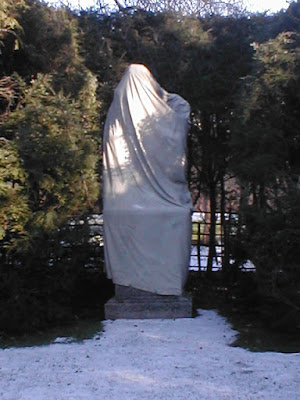I grew up around lots of yew bushes, which is not surprising since the local nursery specialized in them. The hybrid varietal known as the "Hicks yew" -- Taxus x media Hicksii -- was the work of Henry Hicks, a Cornell-educated botanist whose family business was Hicks Nurseries in Westbury, NY. Taxus media is a hybrid of Taxus baccata (English yew) and Taxus cuspidata (Japanese yew). Henry Hicks was considered a leader in hybridizing plants, and his contemporary Frank Meyer (the USDA explorer of Meyer lemon fame), when traveling around the world, would send specimens both to the USDA's research center in Beltsville, MD and Hicks Nurseries.
Above, a "wall" of evergreen yew hedge frames a covered statue at Old Westbury Gardens in mid-winter. Tiny pine cones are visible in the top photo. Other times of year there are small, bright red berries. Hedges like these were one of the specialties of Hicks Nurseries.
Taxaceae is another small family with seven genera and less than forty species. The best known genera are Taxus and Torreya. What is notable about these evergreens, which are used primarily for landscaping, is the presence of a poison called taxol. This substance, derived commercially from Taxus brevifolia -- the Pacific yew -- is used in chemotherapy and is effective in treating a variety of cancers. This is a classic example of a plant providing the key to treating a human disease. For this reason and many others, we owe a huge debt to plants.


No comments:
Post a Comment